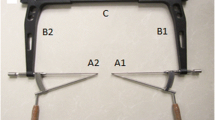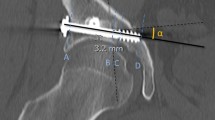Abstract
Introduction
Open reduction and internal fixation has been the gold standard for displaced fracture involving weightbearing dome and fractures with intra-articular fragments. However, extensile exposure can lead to complications. Fracture with minimal displacement can be fixed by a minimally invasive method. Percutaneous screwing for an anterior column fracture of acetabulum under conventional 2D fluoroscopy is a demanding technique. With fluoroscopic-based computerized navigation, we can determine the position of a screw real time intra-operatively with less exposure to radiation. We proposed that a fluoroscopy-based computerized navigational system would simplify operation procedures. The purpose of this study is to test the application of the fluoroscopy-based computerized navigational system for anterior column fracture of acetabulum.
Materials and methods
A prospective cohort study was conducted. Three patients with mildly displaced or non-displaced anterior column fracture of acetabulum were treated with a retrograde lag screw under a fluoroscopy-based computer navigation system. There were two males and one female with a mean age of 39 years and all patients were followed up for more than 1 year. Patients were allowed to perform joint movement exercises and to walk with partial weightbearing on the first day post-operatively.
Results
The mean operation time was 40 min (range 30–45 min) from the use of fluoroscopy to wound closure and the mean total fluoroscopy time was 38 s (range 35–45 s). Total blood loss was less than 10 ml. The patients were pain free 1 week after the operation and had good functional recovery thereafter. No complication was noted postoperatively.
Conclusion
Though the indication for this procedure is limited, we think that there should be potential to apply the screw with less radiation by fluoroscopic-based computerized navigation. Once anatomic reduction can be achieved by the close method in the anterior column fracture of the acetabulum, percutaneous screw fixation under fluoroscopic-based computerized navigation could be a reliable method; however; validating the position of the guide pin and screw by fluoroscopy is suggested.

Similar content being viewed by others
References
Crowl AC, Kahler DM (2002) Closed reduction and percutaneous fixation of anterior column acetabular fractures. Comput Aided Surg 7:169–178
Gay SB, Sistrom C, Wang GJ, Kahler DA, Boman T, McHugh N, Goitz HT (1992) Percutaneous screw fixation of acetabular fractures with CT guidance: preliminary results of a new technique. AJR Am J Roentgenol 158:819–822
Letournel E (1980) Acetabulum fractures: classification and management. Clin Orthop Relat Res 81–106
Matta JM (1998) Percutaneous fixation of acetabular fractures. J Orthop Trauma 5:370
Matta JM, Merritt PO (1988) Displaced acetabular fractures. Clin Orthop Relat Res 83–97
Mosheiff R, Khoury A, Weil Y, Liebergall M (2004) First generation computerized fluoroscopic navigation in percutaneous pelvic surgery. J Orthop Trauma 18:106–111
Mouhsine E, Garofalo R, Borens O, Wettstein M, Blanc CH, Fischer JF, Moretti B, Leyvraz PF (2005) Percutaneous retrograde screwing for stabilisation of acetabular fractures. Injury 36:1330–1336
Norris BL, Hahn DH, Bosse MJ, Kellam JF, Sims SH (1999) Intraoperative fluoroscopy to evaluate fracture reduction and hardware placement during acetabular surgery. J Orthop Trauma 13:414–417
Parker PJ, Copeland C (1997) Percutaneous fluoroscopic screw fixation of acetabular fractures. Injury 28:597–600
Routt ML Jr., Simonian PT, Grujic L (1995) The retrograde medullary superior pubic ramus screw for the treatment of anterior pelvic ring disruptions: a new technique. J Orthop Trauma 9:35–44
Starr AJ, Jones AL, Reinert CM, Borer DS (2001) Preliminary results and complications following limited open reduction and percutaneous screw fixation of displaced fractures of the acetabulum. Injury 32 Suppl 1:SA45–SA50
Starr AJ, Reinert CM, Jones AL (1998) Percutaneous fixation of the columns of the acetabulum: a new technique. J Orthop Trauma 12:51–58
Author information
Authors and Affiliations
Corresponding author
Additional information
The authors declare that no funding or any other kind of financial support was got for this study.
Rights and permissions
About this article
Cite this article
Lin, YC., Chen, CH., Huang, HT. et al. Percutaneous antegrade screwing for anterior column fracture of acetabulum with fluoroscopic-based computerized navigation. Arch Orthop Trauma Surg 128, 223–226 (2008). https://doi.org/10.1007/s00402-007-0369-9
Received:
Published:
Issue Date:
DOI: https://doi.org/10.1007/s00402-007-0369-9




